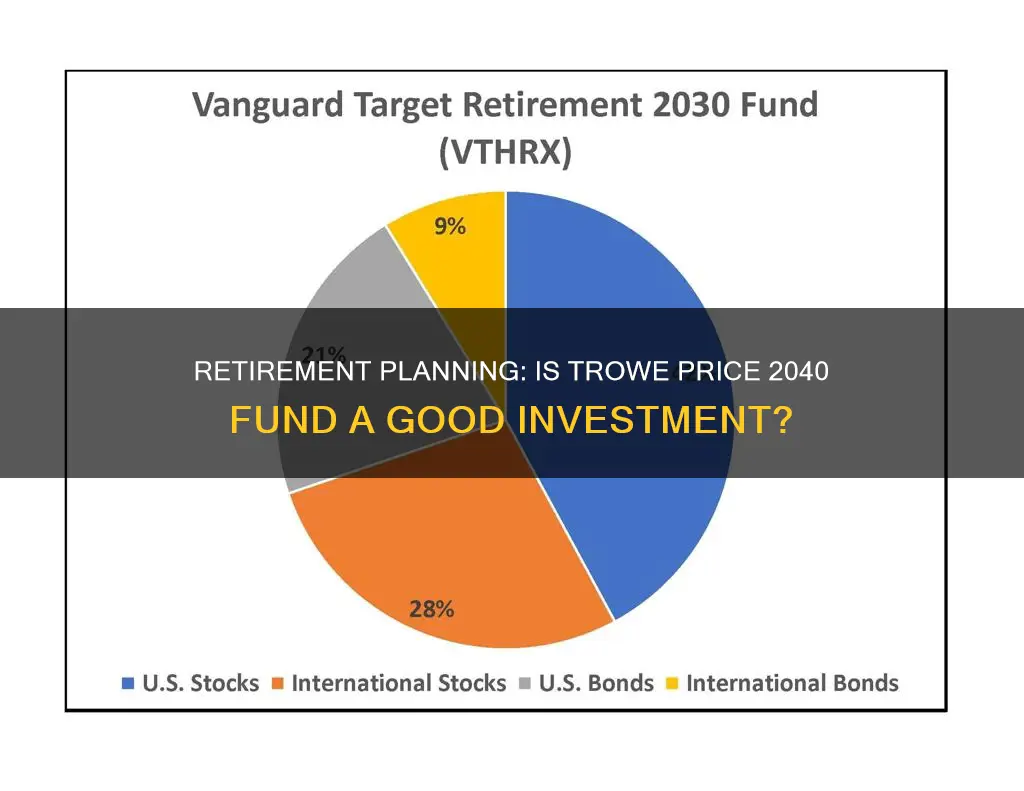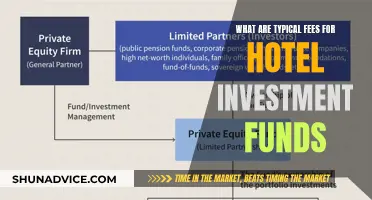
The T. Rowe Price Retirement 2040 Fund is tailored for people who expect to retire between 2036 and 2040. It is designed to provide the highest total return over time, with a focus on both capital growth and income. The fund has a large blend investment style and a medium to moderate sensitivity to interest rates and credit quality. With a history of outperforming its category average, the fund offers a set and forget option for retirement savers, gradually becoming more conservative as the investor approaches retirement age.
What You'll Learn

T. Rowe Price Retirement 2040 Fund's performance and outlook
The T. Rowe Price Retirement 2040 Fund is tailored for people who expect to retire between 2036 and 2040. It is based on a glide path that gradually becomes more conservative as the investor approaches age 65. With the retirement date 15 years away, the fund holds 87% of assets in stocks, with the remainder in bonds, and a small holding in cash. As of 27 November 2023, the fund had assets totalling almost $11.64 billion invested in 31 different holdings. Its portfolio consists of underlying T. Rowe Price stock and bond funds. About 56% of the equity allocation is in US stocks, with the remainder in developed and emerging foreign stocks. The largest single holding is the T. Rowe Price Growth Stock Fund, an actively managed large-cap fund. The top six holdings are all stock funds, as a person who is 11 to 15 years from retirement can still afford to take some significant market risk.
The fund was established in 2002 and is managed by Jerome Clark, who has been with T. Rowe Price since 1992. Clark has given the glide path a heavier stock tilt than found at some rival target-date fund families. It's riskier than a fund with reduced stock exposure, but it also generally results in higher returns. The fund is part of Morningstar's Target Date 2036-2040 category and is benchmarked directly against its peers. On a three- and five-year basis, which coincides with the equity market rally, the fund has outperformed its category average. The fund has returned 8.23% over the past year, 4.84% over the past three years, 6.94% over the past five years, and 7.03% over the past decade.
However, investors should be aware that when the stock market as a whole goes into a correction, other target-date funds with smaller equity weightings may outperform this fund. This knowledge is built into the manager's forecasts for an overall expected return. While this allocation resulted in a sharper decline than the category average in 2008, it also meant significant category outperformance in years such as 2009 and 2013 when the US stock market posted sizable gains. Clark's forecast is not a way of telegraphing shifts in investment philosophy based on a market outlook but is instead a way of setting expectations for performance in the near and medium terms.
Clark does not tinker with the glide path's pre-determined allocations but simply executes the predetermined strategy, rebalancing as needed to keep allocations in line with the fund's mandate. Morningstar calls the fund a "core" holding.
Wide Moat Fund: Investing in Quality Businesses
You may want to see also

The fund's asset allocation and investment strategy
The T. Rowe Price Retirement 2040 Fund is tailored for people who expect to retire between 2036 and 2040. It follows a "glide path", which means the asset allocation becomes more conservative as the investor approaches retirement age. This makes it a "set and forget" option for retirement savers.
The fund's current asset allocation is 87% in stocks and the remainder in bonds, with a small holding in cash. 56% of the equity allocation is in US stocks, with the rest in developed and emerging foreign markets. The largest single holding is the T. Rowe Price Growth Stock Fund, an actively managed large-cap fund. The top six holdings are all stock funds, as investors who are 11 to 15 years from retirement can afford to take on significant market risk.
The fund's investment objective is to seek the highest total return over time, with an emphasis on both capital growth and income. It invests in a diversified portfolio of other T. Rowe Price stock and bond funds, representing various sectors and asset classes. As the investor's retirement date approaches, the allocation will shift to a more conservative mix of T. Rowe Price stock and bond funds.
The fund's expense ratio is 0.60%, which is higher than the category average of 0.43%. This means investors need to consider the potential impact of higher fees on their overall returns.
Overall, the T. Rowe Price Retirement 2040 Fund offers a "core" holding for investors seeking a balanced approach to saving for retirement. The fund's asset allocation and investment strategy are designed to provide a combination of capital growth and income, with a gradual shift to more conservative investments as retirement approaches.
Strategies for Picking a Hedge Fund to Invest In
You may want to see also

The fund's suitability for your retirement goals
The T. Rowe Price Retirement 2040 Fund is tailored for people who expect to retire between 2036 and 2040. It is designed to provide the highest total return over time, with a focus on both capital growth and income. This makes it a suitable option for individuals seeking to grow their retirement savings and generate a steady stream of income.
The fund follows a "glide path", meaning it gradually becomes more conservative as the investor approaches retirement. This strategy is often referred to as a "set and forget" option, as it does not require active management from the investor. As of November 27, 2023, the fund held 87% of its assets in stocks, with the remainder in bonds and a small holding in cash. This mix will shift over time, with a minimum equity exposure of approximately 30% reached 30 years after the expected retirement date.
The fund has a large blend investment style, with a mix of underlying T. Rowe Price stock and bond funds representing various sectors and asset classes. As of September 30, 2024, the top 10 holdings made up 80.4% of the portfolio, including the T. Rowe Price Value Z, T. Rowe Price Growth Stock Z, and T. Rowe Price Equity Index 500 Z funds. The fund has a total net asset value of $8.921 billion, with a net expense ratio of 0.60%.
It's important to note that the fund carries risks associated with both stock and bond investments. A heavier tilt towards stocks means the fund could be subject to sharp declines during market corrections. Additionally, investors are exposed to interest rate and credit quality risks through the bond holdings.
Overall, the T. Rowe Price Retirement 2040 Fund is a suitable option for individuals seeking a hands-off approach to their retirement savings, with a focus on capital growth and income. The fund's glide path strategy ensures a gradual shift to more conservative investments as retirement approaches. However, investors should be mindful of the potential risks involved, particularly those associated with stock market corrections.
Mutual Fund Tax: What Investors Need to Know
You may want to see also

The fund's expense ratio and fees
The T. Rowe Price Retirement 2040 Fund has an expense ratio of 0.60%, which is relatively high compared to its category average of 0.43% and 0.24%. This expense ratio is a percentage of assets under management, which is calculated based on the fund's investment management business.
The fund's distribution fee is also listed as "average" by Morningstar. The fund carries the risks found in both stock and bond asset classes due to its tilt towards stocks, which could result in sharp declines during a market correction, as seen in 2008.
Additionally, investors in the target-date fund are exposed to bonds, which carry interest rate and credit quality risks. The interest rate risk is associated with fixed-rate debt instruments, where a rise in interest rates leads to a decline in their price and vice versa. Credit quality risk refers to the potential loss in value of non-US securities due to adverse local, political, social, or economic developments, as well as changes in exchange rates.
Overall, the T. Rowe Price Retirement 2040 Fund's fees and expense ratio are slightly higher than average, and investors should be aware of the associated risks, particularly those related to stock and bond market fluctuations.
Indexing in Mutual Funds: Abusive or Strategic?
You may want to see also

The fund's management team and experience
The Funds Management Team and Experience
The T. Rowe Price Retirement 2040 Fund has been managed by Jerome Clark since 2002. Clark joined T. Rowe Price in 1992 and also manages several other target-date strategies at the firm. He is a member of the company's asset allocation committee and is supported by a team of co-managers and analysts.
Clark and his team were nominated for Morningstar's 2012 Allocation Fund Manager of the Year Award. Morningstar has also rated the fund a "core" holding, stating that T. Rowe Price Retirement's skilled team implements a "collaborative, research-driven approach that continues to instill confidence over the long run."
Clark's strategy for the fund has been to give the glide path a heavier stock tilt than some rival target-date fund families. This approach is riskier than a fund with reduced stock exposure, but it has generally resulted in higher returns. This was particularly beneficial for investors after 2009, when stock markets entered a strong bull run.
The fund has returned 8.23% over the past year, 4.84% over three years, 6.94% over five years, and 7.03% over the past decade.
A Guide to Investing in Motilal Oswal S&P 500 Index Fund
You may want to see also
Frequently asked questions
The T. Rowe Price Retirement 2040 Fund is tailored for people who expect to retire between 2036 and 2040. It is based on a glide path that gradually becomes more conservative as an investor approaches age 65.
The fund seeks the highest total return over time, consistent with an emphasis on both capital growth and income.
The fund's expense ratio is 0.60%.
As of July 2024, the fund's total net assets were valued at $8.921 billion.
The fund has returned 8.23% over the past year, 4.84% over the past three years, 6.94% over the past five years and 7.03% over the past decade.







